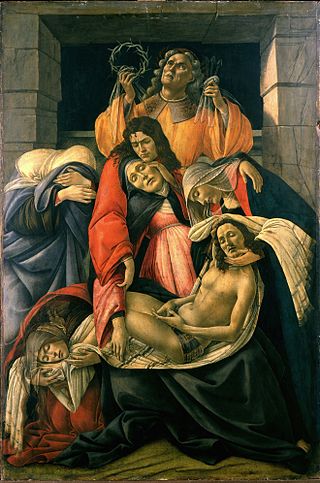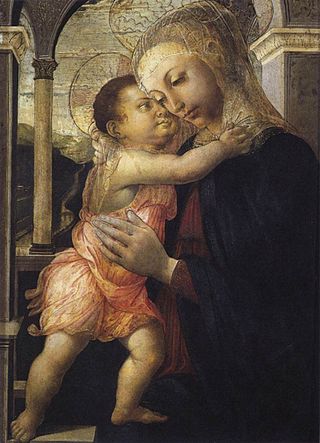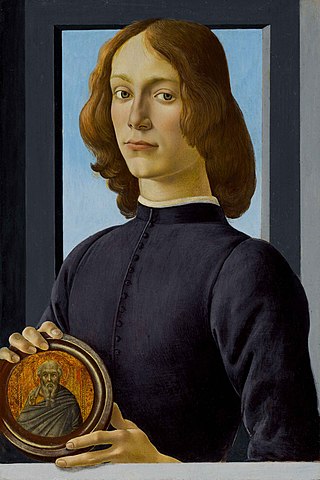
The Uffizi Gallery is a prominent art museum located adjacent to the Piazza della Signoria in the Historic Centre of Florence in the region of Tuscany, Italy. One of the most important Italian museums and the most visited, it is also one of the largest and best-known in the world and holds a collection of priceless works, particularly from the period of the Italian Renaissance.

Alessandro di Mariano di Vanni Filipepi, better known as Sandro Botticelli or simply Botticelli, was an Italian painter of the Early Renaissance. Botticelli's posthumous reputation suffered until the late 19th century, when he was rediscovered by the Pre-Raphaelites who stimulated a reappraisal of his work. Since then, his paintings have been seen to represent the linear grace of late Italian Gothic and some Early Renaissance painting, even though they date from the latter half of the Italian Renaissance period.
The year 1500 in art involved some significant events and new works.

The Madonna of the Pomegranate was painted in circa 1487 with tempera on a wood panel by Sandro Botticelli. It is now in the Uffizi in Florence. Sandro Botticelli was a leading Italian Renaissance artist from Florence, Italy. The Madonna (art) uses the circular format, better known as a tondo, which focuses the attention on the main characters, the Virgin Mary and baby Jesus, who are surrounded symmetrically by angels on each side. Botticelli's use of tempera grassa give the characters a real look, better known as a "naturalistic" style, which is common during the Renaissance. The Virgin Mary is holding baby Jesus gently in her arms while holding a pomegranate in her left hand.

The Madonna of the Book, or the Madonna del Libro, is a small painting by the Italian Renaissance artist Sandro Botticelli, and is preserved in the Poldi Pezzoli Museum in Milan. The painting is executed in tempera on panel. It dates from between 1480 and 1481.

Madonna in Glory with Seraphim is a painting by the Italian Renaissance painter Sandro Botticelli, executed c. 1469–1470. It is housed in Galleria degli Uffizi.

The Mystical Nativity is a painting in oil on canvas dated c. 1500–1501 by the Italian Renaissance master Sandro Botticelli, in the National Gallery in London. It is his only signed work and has an unusual iconography for a painting of the Nativity.

The Lamentation over the Dead Christ with Saints is a painting of the Lamentation of Christ by the Italian Renaissance artist Sandro Botticelli, dated between 1490 and 1495. The painting was originally kept in Santa Maria Maggiore, Florence. It is now in the Museo Poldi Pezzoli of Milan. The painting is one of two versions of The Lamentation by Botticelli. The other, circa 1492, is now in the Alte Pinakothek in Munich.

The Madonna of the Magnificat, is a painting of circular or tondo form by the Italian Renaissance painter Sandro Botticelli. It is also referred to as the Virgin and Child with Five Angels. In the tondo, we see the Virgin Mary writing the Magnificat with her right hand, with a pomegranate in her left, as two angels crown her with the Christ child on her lap. It is now in the galleries of the Uffizi, in Florence.

Madonna Adoring the Child with Five Angels is a tondo or round painting by the Italian Renaissance master Sandro Botticelli, completed between 1485 and 1490. It is housed in the Baltimore Museum of Art, in Baltimore, Maryland. The medium is tempura and oil on a round wood panel. It is part of the Mary Frick Jacobs Collection.

The Madonna della Loggia is a painting attributed to the Italian Renaissance artist Sandro Botticelli, dating to c. 1467. A tempera on panel work, it is located in the loggia of Uffizi, Florence, Italy.

The Lamentation of Christ is a very common subject in Christian art from the High Middle Ages to the Baroque. After Jesus was crucified, his body was removed from the cross and his friends mourned over his body. This event has been depicted by many different artists.

Modern Rome – Campo Vaccino is a landscape by British artist Joseph Mallord William Turner completed in 1839. It is Turner's final painting of Rome and had been in the possession of the family of the 5th Earl of Rosebery since 1878, until the painting came to auction, 7 July 2010. It was bought by the J. Paul Getty Museum, Los Angeles, and was subject to an export bar to allow a British gallery time to attempt to match the Getty's bid.

The Madonna and Child with an Angel is a painting by the Italian Renaissance painter Sandro Botticelli, c. 1465–1467. It is housed in Spedale degli Innocenti of Florence.

Salvator Mundi is a painting attributed in whole or in part to the Italian High Renaissance artist Leonardo da Vinci, dated to c. 1499–1510. Long thought to be a copy of a lost original veiled with overpainting, it was rediscovered, restored, and included in an exhibition of Leonardo's work at the National Gallery, London, in 2011–2012. Christie's, who sold the work in 2017, stated that most leading scholars consider it an original work by Leonardo, but this attribution has been disputed by other leading specialists, some of whom propose that he only contributed certain elements; and others who believe that the extensive restoration prevents a definitive attribution.

The Museum & Gallery, Inc. is currently located on the campus of Bob Jones University in Greenville, South Carolina. It was established in 1951, and focuses on sacred art, mainly European Old Master paintings, but also includes smaller collections of sculpture, furniture, architectural elements, textiles, Greek and Russian icons, and ancient artifacts. As of 2017, the museum is closed for a planned move to downtown Greenville, SC.

The Mocking of Christ is a small 13th-century panel painting by the Italian artist Cimabue, in tempera on a poplar panel. It depicts the mocking of Jesus and is one of three panels known from Cimabue's Diptych of Devotion. It was discovered in the kitchen of an elderly woman in northern France. In October 2019 it sold at auction for €24 million, a record for an artwork predating the 16th century. It is believed to be the first work by Cimabue to have been auctioned. Following an export ban, it was acquired by the Louvre in 2023.

The Portrait of a Young Man Holding a Roundel is a painting attributed to Sandro Botticelli. Due to its style it has been estimated to have been painted around 1480. The identity of the portrait's subject is unknown, but analysts suggest it could be someone from the Medici family, as Lorenzo de' Medici was one of Botticelli's main benefactors.


















